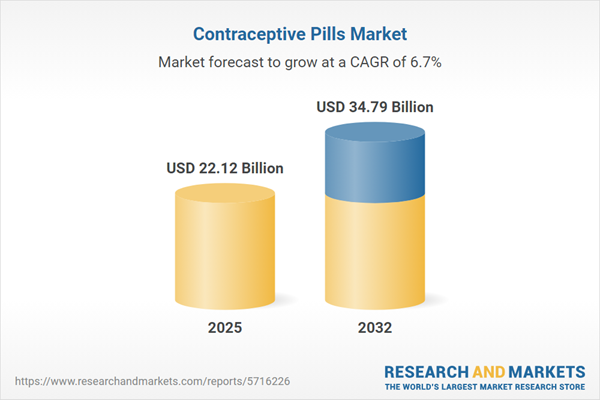Speak directly to the analyst to clarify any post sales queries you may have.
The contraceptive pills market is evolving rapidly amid healthcare innovation and intensified regulatory demands. Senior leaders need concise market intelligence to stay ahead of competition, respond to shifting consumer expectations, and seize growth opportunities globally while navigating policy and technology disruptions.
Market Snapshot: Growth and Trends in the Contraceptive Pills Market
Robust compound annual growth and increasing global demand are transforming the contraceptive pills market. Adoption has accelerated, with digital integration and ongoing product innovation establishing a dynamic competitive landscape. Telehealth, expanded product formats, and alternative distribution models foster a flexible marketplace. Companies, from established multinationals to new entrants, are aligning portfolios with demand for personalized healthcare solutions. Despite regional variations in uptake, improved access to reliable contraception continues guiding investment. Competitive intensity is elevated as organizations focus on advancing user safety and streamlining access.
Scope & Segmentation
- Formulation Types: Combination pills—available as biphasic, monophasic (including low, standard, and ultra-low dose options), quadriphasic, and triphasic—offer thoughtful solutions for varying patient profiles. Progestin-only pills provide an alternative tailored to specific health needs and preferences.
- Packaging Formats: Blister and strip packs are engineered for efficient pharmacy processes and diverse consumer groups, improving accessibility and ease of use.
- Dosage Cycles: Choice spans 21-day, 28-day, and extended regimens, allowing users to select based on menstrual cycle and adherence needs.
- Pricing Tiers: Both branded and generic contraceptive pills maintain broad affordability, ensuring market access for multiple consumer segments without compromising quality.
- Distribution Channels: Availability is assured through clinics, hospitals, retail pharmacies, and online platforms, delivering coverage to both urban and rural populations.
- End User Profiles: Adolescent through adult populations are supported, assisting market participants in tailoring engagement strategies to unique age groups and usage patterns.
- Regional Coverage: Strategic insights address key growth and established regions, including the Americas, Europe, Middle East, Africa, and Asia-Pacific, enabling market leaders to calibrate approaches for local dynamics.
- Key Companies: Industry leadership and strategic innovation are driven by major organizations including Bayer AG, Pfizer Inc., Organon & Co., Johnson & Johnson, Teva Pharmaceutical Industries Ltd., Viatris Inc., Novartis AG, Aurobindo Pharma Limited, Sun Pharmaceutical Industries Limited, and Cipla Limited.
Key Takeaways
- Continuous product enhancements are supporting user adherence and satisfaction, with companies investing in new hormonal formulations and regimens extending beyond conventional cycles.
- Digital transformation, led by telehealth and mobile integration, is increasing patient engagement and enabling timely access to contraceptive services across diverse markets.
- Shifts in regulatory expectations are expediting product approval timelines and supporting more transparent management of product lifecycles, helping businesses strengthen market positioning.
- Sustainability is taking on greater importance in operational planning, as organizations adopt eco-friendly packaging and sustainable manufacturing practices in response to stakeholder commitments.
- Global expansion, local partnerships, and optimization of supply and distribution models are equipping organizations to consistently capture momentum within both mature and emerging markets.
Tariff Impact: Navigating US Policy Changes
Recent tariff adjustments in the United States have increased costs across procurement and supply chains. In response, manufacturers and distributors are diversifying supplier networks, forming regional partnerships, and investing in domestic production facilities. These adaptive measures are essential for safeguarding business continuity and managing pricing strategies while maintaining compliance with evolving regulatory requirements.
Methodology & Data Sources
The research integrates secondary and primary data, including detailed interviews with sector experts and broad-based surveys of stakeholders globally. Insight from healthcare professionals and industry leaders informs rigorous data validation and nuanced analysis supporting actionable recommendations.
Why This Report Matters
- Empowers executive teams to optimize product strategy and expand effectively, mitigating risks caused by complex global regulatory shifts.
- Supports proactive adaptation to technology adoption, regulatory change, and evolving stakeholder needs within the contraceptive pills industry.
- Provides decision-makers with actionable clarity across international and local markets, ensuring sustainable competitive advantage.
Conclusion
This report enables leaders to strengthen organizational resilience and guide responsible growth by addressing regulatory, digital, and sustainability priorities in a changing global market landscape.
Additional Product Information:
- Purchase of this report includes 1 year online access with quarterly updates.
- This report can be updated on request. Please contact our Customer Experience team using the Ask a Question widget on our website.
Table of Contents
3. Executive Summary
4. Market Overview
7. Cumulative Impact of Artificial Intelligence 2025
Samples

LOADING...
Companies Mentioned
The key companies profiled in this Contraceptive Pills market report include:- Bayer AG
- Pfizer Inc.
- Organon & Co.
- Johnson & Johnson
- Teva Pharmaceutical Industries Ltd.
- Viatris Inc.
- Novartis AG
- Aurobindo Pharma Limited
- Sun Pharmaceutical Industries Limited
- Cipla Limited
Table Information
| Report Attribute | Details |
|---|---|
| No. of Pages | 183 |
| Published | October 2025 |
| Forecast Period | 2025 - 2032 |
| Estimated Market Value ( USD | $ 22.12 Billion |
| Forecasted Market Value ( USD | $ 34.79 Billion |
| Compound Annual Growth Rate | 6.6% |
| Regions Covered | Global |
| No. of Companies Mentioned | 11 |









